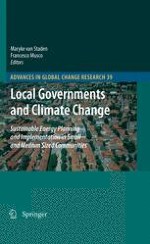Global warming is changing the world as we know it. Climate change can have catastrophic impacts in numerous cities across the world. It is time for us to react – quickly and effectively. The European Community (EC) has been leading the fight against climate change, making it one of its top priorities. We have introduced the most ambitious targets of their kind, known as the “20/20/20 by 2020” initiative within the “Climate Action and Renewable Energy Package.” As a result, European Member States have taken on a commitment to curb their CO emissions by at least 20% by 2020. 2 These targets are indeed commendable; however, they are only the start if we are to avoid the consequences of global warming. Whilst top level coordination from the European Institutions and Member State governments is vital, the role of mitigating and adapting to climate change at local level must not be forgotten. In fact, here cities, regions and their citizens play a significant a role. It is therefore vital they become directly involved in the climate change challenge. The European Commission therefore launched in 2008 a new initiative, the Covenant of Mayors, which brings together a network of European mayors in a voluntary effort to go beyond the European Union’s already ambitious targets. Half of our greenhouse gas emissions (GHGs) are created in and by cities.
